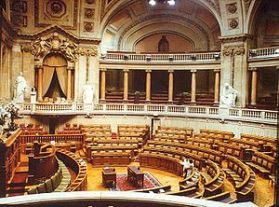Portugal's government and administrative structure has changed many times in the past 100 years, since the New Republic was formed. Here is a brief summary to help you to understand the systems and the difficulties.
President and Assembly
The President of the Republic of Portugal is the head of state and is elected every 5 years. 
The Assembly of the Republic (Assembleia da República) is the Portuguese parliament. It is located in a historical building in Lisbon, referred to as Palácio de São Bento, the site of an old Benedictine monastery. The Palace of São Bento was formerly known as the seat of the National Assembly (Assembleia Nacional) during the Estado Novo regime.
The Assembly is made up of between 180-230 elected members. Members are decided bases on Proportional Representation system of election, and elections are held every 4 years.
The President of the Assembly is usually nominated by the majority party, and the Prime Minister is appointed by the President of teh Republic.
Administrative Divisions
Between 1926 and 1974 the administration of Portugal was very centralised and was divided into 20 Districts, 18 on Mainland Portugal plus the Azores and Madeira. This district system dates back to 1835 and it still the bases of electoral division, football associations and more.
The current government structure is based on the 1976 Constitution, adopted after the 1975 Carnation Revolution. It allows a high degree of freedom for the lower tiers of government; civil parishes (freguesias), municipalities (municípios or concelhos) and administrative regions (regiões administrativas) to decide their own expenditures.
A referendum was conducted in 1998 in order to implement an change to 8 mainland statutory and political regions with some degree of autonomy and to abolish districts, but it was rejected.
The "district" has been removed from the legal framework, but still remains an important and relevant division and it is still recognized by the general public.
In addition, in May 2003 a new law allowed the municipalities to organize themselves into inter-municipal communities (comunidades intermunicipais), that can be of general or specific purposes; and metropolitan areas (áreas metropolitanas), that can be of two types: great metropolitan areas (grandes áreas metropolitanas) of which there are 7, and urban communities (comunidades urbanas), there are 12 of these.
The 2011 bailout accord requires the reduction of the number of municipal and parish local governments after July 2012. In 2014 is changed to 2 Metropolitan Areas (Lisbon and Oporto), 21 Interminicupal Communities and 308 Municipalities. Within these many freguisias have also been joined together, you will see the changes on any recent paperwork regarding houses. Most of the Silver Coast comes under the West Region (Regiao de Oeste). Check Wiki for more details.
Portugal was redefined during European integration, for statistical purposes. The name used for this is NUTS (Nomenclature of Territorial Units for Statistics) there are 3 regional levels (I, II, III) for this purpose. Although the NUTS regions are used by the Portuguese government, they do not have a legal status in law but are used throughout the EU for statistical purposes.
Local Elections
Municipal elections are being held in 2017, and voting will take place for all seats.
The Portuguese local elections in 2017 take place on 1st October. There are three separate elections in all the 308 Portuguese municipalities, the election for the Municipal Chambers, whose winner is elected mayor (president), another election for the Municipal Assembly, and an election for the lower-level Freguesia Assembly, again with a local mayor/president. The Freguesia election will be held in the more than 3,000 parishes/freguesias around the country.
All 308 municipalities are allocated a certain number of councilors to elect corresponding to the number of registered voters in that municipality. Each party or coalition must present a list of candidates.
If you are a resident in Portugal then you are entitled to vote in your local elections. To register, go to local Freguesia with your ID and proof of residency.


